Margate Parish Church (St John the Baptist) Monuments
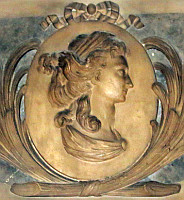
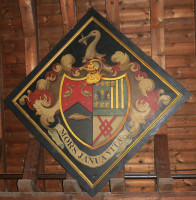
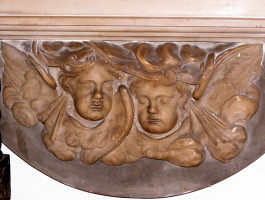
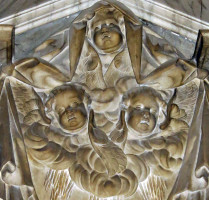
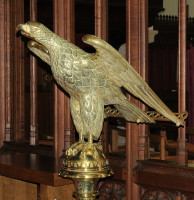
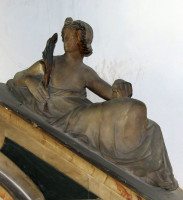
The Parish Church in Margate, St John the Baptist, commands a fine aspect from something of a hill,
found by continuing up the High Street from the town centre all the way. It contains a goodly number of monuments, the interest of this
page, but first a few words on the building itself. It stands in its churchyard, and is a
long, low building save for the three storey tower with spire. It is built of flint, with freestone dressings at the corners
and around windows and portico. Rather than a higher central nave and two lower aisles, there are three equal height
pointed roofs, with the West Tower at the end of the northernmost one.
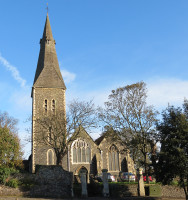 St John the Baptist, Margate.
St John the Baptist, Margate.
The building was originally put up as a small chapel at ease of the mother church at Minster, also in Thanet,
in Norman times, later becoming a separate Parish Church in its own right. It was extended as the town grew,
to its present length. After the normal periods of prosperity decline and neglect, it was restored in the 1870s
by Ewan Christrian, PRIBA, who restored and redesigned many churches, and his is the spire of the North Tower,
replacing a very short one (see the engraving below), as well as a new porch, also on the north side, augmenting the one to the south,
and he also removed galleries from inside; further changes have taken place in modern times.
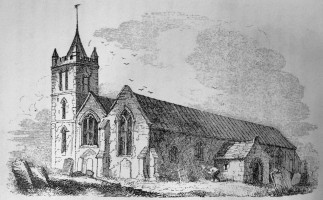
View of Margate Church before the tall steeple was added.
Inside, the Church really is rather large, with its three long aisles and lofty wooden roofs, and though the side aisles
are divided from the nave by Gothic arches with solid Norman pillars to the north changing to later octagonal shafts
further down, this is open enough to enhance the sense of space rather than restricts it. There remains a small gallery
at the West end from which the whole interior can be best seen. All down the walls, and up in this gallery, are the monuments.
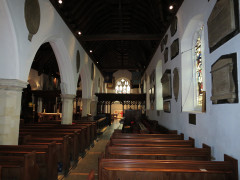
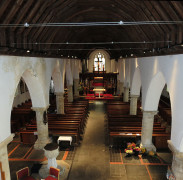 View of nave, and aisle with monuments.
View of nave, and aisle with monuments.
Monuments
There are over 60 stone wall panel or mural monuments within the Church. There are four from the 16th and 17th Centuries,
with writing on black panels, Classical frames and much decorative carving, of whih the Cleybroke monument
has a pair of characteristic kneeling statues and the Valentine Petit memorial has decorative figure sculpture.
From 1700 is a cartouche monument – a shield shaped panel surrounded by carved drapery, cherub heads and so forth,
an elegant sculptural and ornamental alternative to the more architectural rectangular Classical monuments of the times.
Minor sculpture of the 18th Century can be found on two of the memorials, and towards the end of that century are a couple of
rather plain oval panels, and the first of the white panels on black backings which dominated the early 19th Century.
Over half the monuments in the Church are of this white on black type, with a range of simple designs,
with some minor sculptural decoration, through well into the Victorian period. Intermingled among them are
several obelisk monuments, where the upper part of the monument consists of a black panel cut to obelisk shape
evocative of Egypt, and hence death and rebirth. The mid-Victorian period saw a renaissance of Gothic monuments,
as blind windows, and there are two of these, both from the 1860s, in St John the Baptist. Finally, in the 20th Century,
World War 1 saw a rejection of ornament and a move to austere, unornamented panels,
and there are several of these in the Church. Regrettably, nearly all the monuments are either unsigned
or seem to have had their signatures deliberately obliterated, but the productive partnership of Bacon and Manning
is represented by one monument, and there is another by the relatively obscure monumental mason W. Wood.
We consider them in date order:
16th and 17th Century Monuments
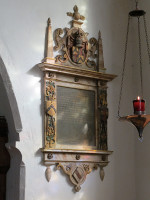 Monument to Henry Crispe, d.1588.
Monument to Henry Crispe, d.1588.
- Henry Crispe, d.1588. A grand early wall tablet, The inscription to the deceased, on a black panel,
notes his relatives, two wives and offspring, and has underneath an inscribed picture of him, reclining, dressed in armour,
but with helm beside him, and holding an unattached head on his knee. There is a wide border,
with the sides decorated with pairs of weapons behind shields of arms, behind which are hanging fruits and ribbons,
most effective as a device. Above and below are shelves, the upper one being large, and bearing upon it a shield of arms
with knight’s helm, small animal on top, and instead of the usual acanthus leaf or feathery surround, a hanging drape.
All this within an oval, with open strapwork surround, in a pink and white alabaster.
On the sides are small obelisks with spiky termini. Under the lower shelf is a short entablature
(there is another below the upper shelf too) with three flowers, and at the base a small apron with a lozenge of arms
in a circle, with florets on each side, and at the corners, hanging pointed pendants. The whole forms a convincing,
spiky composition.
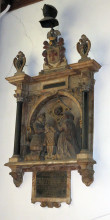
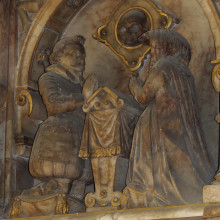 Paul and Marie Cleybroke, a kneeler monument of the 1620s.
Paul and Marie Cleybroke, a kneeler monument of the 1620s.
- Paul Cleybroke, d.1622, and wife Marie (Knatchbull), d.1624, ‘who liveinge longe tyme together
most loveingly, over-lived each other but a small tyme & are here beneth interred together’. A kneeler monument in alabaster.
The figures of husband and wife kneel praying, facing each other across a small prayer-desk with two open books (Bibles).
He is shown as in middle age, bearded and moustached, wearing a full suit of armour, bulging into some pantaloonish expanse
below, kneeling on a tasselled cushion. His wife is shown as a solid figure, cowled and hooded, with long skirts.
They sit within an arched niche, and behind them on the wall, a skull peers out of a circular depression as a memento mori (see picture above right, click to expand).
To the sides are full pillars, Corinthian, with black shafts. Above the arch to left and right in the spandrels
are relief figures of cherubs, and above that, an entablature and a shelf protruding at the corners above the pillars.
On these protruberances are painted shields of arms with winglike surrounds, and in the centre, a larger shield with a Cross,
surrounding ornament, knight’s helm and bird, perhaps an albatross, seated upon it. Above all hangs a funeral helm in
black iron, rather a rarity. Under the lower shelf, the inscription is on a small panel, and to the sides are carved supporting corbels
in the form of cherubic heads. The whole in pink and white alabaster, with small amounts of paint and gilt,
but the figures left in the natural colour of the stone, though the female figure’s cloak shows signs of red paint.
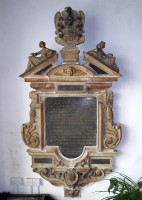
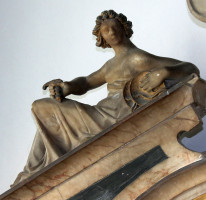
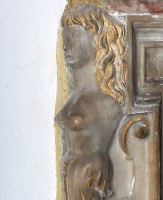
Valentine Petit monument, and details.
- Valentine Petit, d.1626. amd wife Mary [Clyve], d.1609. The most significant sculptural piece in
the Church, and a good example of an early 17th Century Classical Baroque mural monument. The central panel,
with semicircular base, has to left and right the scrolly-sidepieces which are found moderately frequently
from this time onwards, but here the upper parts are formed into grotesque half figures of girls.
By grotesque, here is meant the style where the naturalism of the human figure is entirely subordinated to the requirements
of the design. Thus for each figure we have the head and long neck, armless shoulder and breast, small of the back and flank,
the distance from here to the shoulder being much shorter than proportionate to head and neck, and below,
all dissolves into leafy scrolling, which at the top suggests a skirt, and then with the forward swing of the scroll
approximates to the position of the foot (see picture above right, and click to see whole thing). They have something of the mermaid, something of the caryatid about them,
but are neither. Today, it is hard to feel much artistic sympathy with these disproportionate creations of the Renaissance,
and yet there is skill in the modelling of the musculature of chest and neck, and an appreciation of appropriate scale
to the different elements of the figure and surrounding scrolling. Above, a complex pediment, with inner segment of a circle
enclosing a winged cherub head, within a broader triangular pediment broken at the top to allow for the base of
a large cartouche bearing coat of arms, painted. On the slanting sides of the pediment sit a pair of small statues of girls,
and these are much more conventional to the modern eye than the half-figures below. They are semidraped in Classical drapery,
rolled down to leave shoulders, arms and breasts uncovered, showing a proper Classical physique with strength to
neck and muscular shoulders and arms. Indeed the arms and especially the hands look more refined than the stolidity of the faces.
The figure on the left looks to be Justice, for she holds what may be the remnant of a balance in one hand,
the other holding two pans for weighing, each with a small snake, here emblematic of Wisdom.
She on the right is presumably Literature, her surviving accoutrement being a quill pen.
At the base of the monument is a variety of scrolling and a shield within a small cartouche, and strange flowers with long,
tonguelike tendrils. All of this is in a mix of Alabaster colours and with some paint surviving. An excellent thing overall.
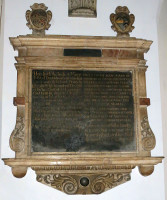 Henry Pettit of Dent de Lyon, d.1661.
Henry Pettit of Dent de Lyon, d.1661.
- Henry Pettit of Dentdelvon [i.e. Dent de Lyon], d.1661, and wife Ann (Finch) Petit (sic), d.1656,
another large, early tablet, with gilt lettering on black, and an alabaster surrounding frame with curly scrolls at the base
of each side, central blocks above in what become pilasters, receding, an entablature above supporting a shelf.
On this rest a pair of coats of arms, in cartouches, one on each side. There would likely have been some central,
larger ornament at one time. At the base, a carved apron with swirls and minor decorative floral carving in relief,
and a central black ball. Not a conventional work.
- Captain John Petit, of Dent de Lyon, d. 1700, erected by his wife Sarah, daughter of Major Somner.
Noted here rather than below to keep with the other Petit monuments. A fine cartouche, with the central inscribed panel
in an elongated hexagonal shape, with winged cherubs at the lower sides, the wings being most unusual, and then above,
a mix of scrolling and knotted drapery, the knots as usual being at the upper sides, and with hanging drop folds beneath.
At the top, more scrolling, and a circular shield fo arms, painted, or almost drawn rather. At the base, an oval coat of arms,
again with outlines rather than more paint, with a small wreath around it, and an Acanthus support below. This really is
a well designed piece, showing originality of design and drapery within an established class of monument,
and with the scale of the carving appropriate to the size of the monument.
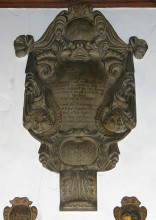 Cartouche to Captain John Petit of Dent de Lyon, d.1700.
Cartouche to Captain John Petit of Dent de Lyon, d.1700.
Monuments after 1700
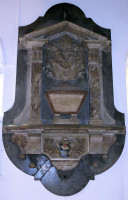 William Payne monument.
William Payne monument.
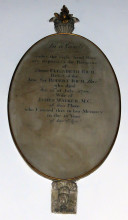
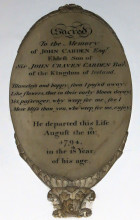
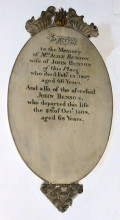
Compositions based on the oval: Rich, Carden and Benson.
19th Century Monuments:
- Mary North, d.1802. An oval panel not far off the circular, rounded at the edge, resting on a small support
carved with little leaves.
- William Brown, d.1799, and wife Martha, d.1804, erected by her brother Joel Culmer.
At the very end of the period of coloured marbles, and with a mix of white, streaky black and white, slight pinkish tint,
and brecciated or lumpy light grey on black. An obelisk monument, with the Egyptian connotations of death and rebirth,
the obelisk here being something over 3/5 of the height of the monument, and slenderer than some –
we shall meet a couple of the more broad obelisk styles below (monuments to Coghlan and Slater - see below for pictures of all three).
Upon it is a pot in low relief, partially draped and with leafy branches across and by it, rather nice,
and a cameo of a female face. Above, a roundel with two more relief profiles, male and female, young,
and so close their noses almost touch; a bow is carved above with two small festoons. The obelisk rests on a shelf,
at the sides of which are two lanterns in the form of shells. Beneath, the lower part of the monument,
consisting of the inscribed panel with borders, a lower shelf, and a curvy apron with a small winged cherub head at the base.
A good example of this type of monument, grander than the normal panel. A generation later,
the genre was popular in three dimensions in the many obelisks found in Victorian cemeteries.
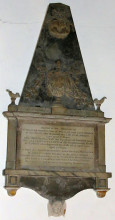
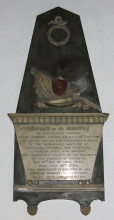
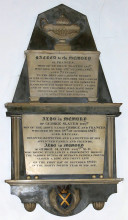
Obelisk panels of the early 19th Century.
- Nathaniel Hodges, d.1806, and son James Hodges, d.1804. Rectangular panel with black border,
upper shelf, above which the black marble is cut to form a convex-edged shape, taller than a pediment, shorter than an obelisk,
not unpleasing. On this is a device of two oval disks, one partially in front of the other, each with three cut crescents,
and a crown on top. Two supporting blocks at the base. Curious.
- Isabel Rachel Rebecca Akers, d.1797, and Edmund Fleming Akers, d,1807, infants.
A plain panel with pointed top on similarly shaped black backing.
- Henriette Louise Vardon, d.1807. A chest tomb, or altar tomb if indoors,
is a great brick shaped monument usually with pilasters (relief pillars) at the corners, and either a flat panel
or a slanted lid or some pot or other ornament on top. For two-dimensional mural monuments, we have the ‘chest tomb end’,
as if looking from one end of such a monument. These are a very popular design, and this is the first of several examples
in the church. Thus to the sides of the panel (the end of the chest tomb) we have fluted side pilasters, to the top,
an upper shelf bearing a flaming urn, against a black backing cut to a wavy shape, and at the base, to two feet
below little leafy corbels underneath the pilasters.
- Alice Benson, d.1807, and husband John Benson, d.1808. Long oval panel with upper and lower
minor sculptural ornament; at the top, shells, some scrolly leaves or seaweed, and a small central flame, and at the base,
a triangular support with symmetrical leaf designs.
- Ann Maddison, d.1808. Another oval, plain, with a tiny supporting shelf with leafs carved in relief.
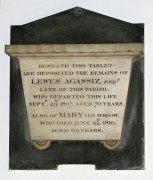
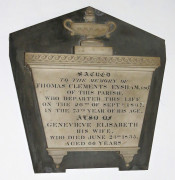
Casket tomb ends: Lewes Agassiz, d.1807, and Thomas Eysham, d.1837.
- Lewes Agassiz, d.1807 (perhaps ‘Lewis’ would be the modern spelling), and wife Mary, d.1810.
As we have the chest tomb end, so we have the casket tomb end, where the three dimensional version familiar from the Churchyard
is a casket-shaped piece standing on short legs, lighter and more elegant than a chest tomb. On this example
we have the sloping sides, upper shelf and lower rounded feet, but the casket lidless, and the black backing cut
to have its own little feet and a pediment shape above.
- George Readhead, d.1810, from a fall from his horse. A plain, horizontal oval,
less usual than the type with the longer diameter vertical, and the only example in the Church.
- Ann Sawkins, d.1810. Panel with narrow inscribed border, upper shelf bearing acroteria (the ‘ears’ we
have already met before) and a pot with drapery carved in relief, against a black backing panel like a mini-obelisk,
but too broad and short to be such. At the base, another bit of backing panel, in a segment of a circle and enclosing
a painted shield on a roundel. Carved leafy corbels at the sides. This is the first of several of the tablets from this period
where the mason has aimed for something a bit out of the ordinary, and more experimental than the usual.
- James Cross, d.1813. A panel with broad border, upper and lower shelf, squared off above and below,
the former with a central area slightly projecting, with a low relief carving of a pot, small, but nicely carved with leaves
and repeating balls. The base is cut with two small feet bearing roundels, and the whole monument is in a pleasant combination
of white and grey marble, an early 19th Century translation of the grander Classical monuments of the 17th and 18th Century.
- Lt. Col. John Robert Coghlan, d.1814, ‘who after having distinguished himself
in the memorable battles of Talavera, Vittoria, the Pyrenees, Nivelle, Nive, and Orthes, fell gloriously
leading on his regiment to the heights of Toulouse. A fine obelisk monument, of the type where the top is not much narrowed
from the bottom, giving a coherent single shape to the whole. The obelisk is around 3/5 of the total height,
and has upon it a high relief carving of a crossed flag and sail, the latter wound somewhat round the mast, and in front,
a painted shield of arms. Two cannon complete the martial assemblage, wholly appropriate for a soldier.
Above, a wreath and ribbon. The lower part of the monument consists of the inscribed panel, as a casket tomb end
with outward sloping sides, prominent upper shelf with slight entablature, and resting on ball feet, a convention.
The casket sits on a thin shelf, and below, the backing panel is triple curved to allow for two fluted corbels,
a similar arrangement is adopted in the later monument to Letitia Brooke below, and it may be by the same mason.
- Thomas Walker, d.1815. A casket end, resting on double ball feet, no ledge underneath this time,
a shelf above, and on this, a broad ewer carved in low relief with a small drape across it, and a tiny painted sun.
The discoloured backing panel is cut into a curved pediment with large acroteria. Below, a painted shield of arms.
- Frances Slater, d.1817, son George Slater, d.1817, and husband George Slater, d.1822.
An obelisk monument, a little unusual in design. There are two inscribed panels, each as a casket end, the lower with ball feet,
the upper with briquettes, and resting on the shelf which divides the obelisk backing from the lower half of the monument.
There is a low relief carved pot on the top of the upper panel, so most of the obelisk is in fact obscured.
The middle shelf rests both on the lower panel and on two odd pilasters, with another shelf below, and an apron with shield
of arms and two small clusters of leaves, and fluted jelly mould corbels to the sides.
- Ann Sawkins, d.1818. A casket end monument, with outward slanting sides anda fluted lid,
resting on two balls rather than feet, and supported below on a small shelf; there is a small black backing.
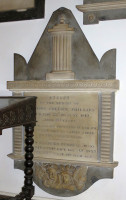 Herriott Collier Phillips, d.1819.
Herriott Collier Phillips, d.1819.
- [Her]riot Collier Phillips, d.1819, and Frances Burrell, d.1833. An interesting monument,
with the panel below a shelf which supports a thick, fluted pillar or pedestal in relief with a small flame on top,
against a backing cut as a very short obelisk with oversized acroteria or ‘ears’ to the sides. At the base,
a pair of winged cherub heads amidst the clouds (see picture above, and the detail of the cherubs at top of page).
- Jacob Sawkins, d.1819. A plain panel with thin upper shelf, which may once have been a border all round;
the husband of Ann Sawkins noted above.
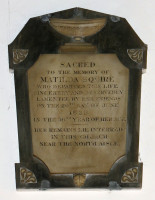 Matilda Squire, d.1822, work of the mason W. Wood.
Matilda Squire, d.1822, work of the mason W. Wood.
- Matilda Squire, d.1822, signed by the mason W. Wood. Another simple but unusual panel.
The inscribed panel has truncated corners, and the black backing has an equal border around these,
with the outer space filled by a recessed anemone-patterned spandrel shape; a single little leaf is central to the base.
At the top, a shallow dish in high relief with the common low relief leaf patterns on the lower body.
- Letitia Brooke, d.1823, as a casket end, thus with outward-angled sides to the panel,
and a pointed lid, and resting on little feet, in this case S-shaped scrolls, which themselves stand on a lower shelf.
Above the casket is a painted shield of arms, and the whole is on a shaped black backing panel, with the lower edge curved,
to allow for two fluted ‘bobble hat’ termini, perhaps intended as stylised flowers.
- Lt. John Jarvis, d.1789, and wife Ann, d.1800, erected by their son Daniel Jarvis, in 1825 –
see below for his monument. Panel with small shelf with patterning, upper section cut roughly to the shape of a pediment,
with anemone acroteria and central half-circle. Very small feet below, and on a black backing panel.
- Elizabeth Leach, d.1825. As a casket end, with upper lid, on which stands small bowl in high relief
with a leafy pattern on the body, against a black almost triangular backing panel.
The casket stands on the familiar double ball feet, resting on a shelf, and below, the backing panel,
pyramid rather than obelisk is cut as a rounded apron.
- Elizabeth Phelps, d.1829, cut to shape as a casket end, with no sculptural decoration;
on a black, shaped backing, cut to give a narrow border all round rather than a blockier shape:
the same is done with the panels to Maria Waddington, John Robason, and the Taddy family,
as opposed to the more usual convention of having a more simply shaped backing (e.g. Robert Salter),
or one cut to make a particular shape in its own right (e.g. Nathaniel Hodges).
- Mary Brooke, d.1830. Panel with slight upper shelf and top cut to pediment shape,
the base with a shelf and cut as a segment of a circle. On a black backing panel.
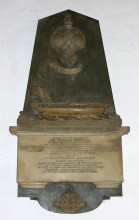 Sir Thomas Staines, designed by Bacon & Manning.
Sir Thomas Staines, designed by Bacon & Manning.
- Sir Thomas Staines of Dent de Lion, d.1830, and wife Sarah Tournay Bargrave, Lady Staines, d.1832.
A short obelisk, if we can so call such a broad shape. The interest is in the relief carving upon it of the hulk of a ship,
on stormy sea, with all sails and masts gone bar one sagging one; above a military coat of arms with two wreathed arms,
medals, and motto (if you like ship sculpture, see this page). A further coat of arms is on the base, and the work is signed by the sculptors Bacon and Manning of London –
this is John Bacon Junior, eminent in his own right, and his partner in monument making
for some considerable time, Samuel Manning.
- Elizabeth Nichelson, d.1831, and daughter Elizabeth, d.1828.
A tomb chest end with tiny feet and a pediment, on a black shaped panel.
- Maria Waddington, d.1832. Panel cut to the shape of a casket end, with acroteria and pediment
rather than a simple lid; the backing panel follows the contour of the casket, giving a distinctive shape.
- Robert Salter, d.1833, and wife Susanna, d.1850. Panel with pointed base, upper shelf,
and a curly pediment directly upon it, made of a pair of scrolls, large in the centre, small at the corners,
to enclose stylised flowers and leaves. At the sides, instead of pilasters, shapes broadening downwards
and enclosing low relief hanging drapes.
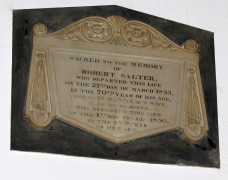
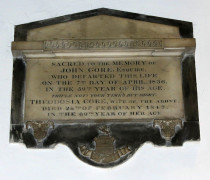
1830s white on black panels: Salter and Gore monuments.
- Daniel Jarvis, d.1833. With a pediment above thin double line of repeating decorative shapes,
and enclosing a wreath and two outward turning leafy branches carved in relief, and the whole of a black backing panel.
- William Hunter, d.1785, and others of his family, with a note that the memorial was erected by
George Yeates Hunter in 1833. Crisp Classical panel, with broad frame, the sides being decorated with downward pointing torches,
and the top, with S-shaped repeating patters, acting as the entablature below a shelf and rimless pediment bearing
central circlet with a painted shield of arms. Two heavy curved brackets at the base.
- John Robason, d.1834, and wife Elizabeth, d.1828. An irregular hexagon,
with similarly shaped black backing.
- Francis Forster, d.1835, and wife Margaret, d.1854. As a tomb chest end,
with an inscribed border around the inscription, and further lines cut to show a pediment and acroteria;
the only sculptural ornament is a small wreath in the pediment, and ringed foliage, stylised, on the little feet.
On a black, shaped backing.
- John Gore, d.1836, and wife Theodosia, d.1847. As a tomb chest end, with wide rim at the top
bearing a low relief repeating pattern, a pediment-shaped lid, and the feet carved with leaves; the black backing panel curves
down at the base to allow for a small carved shield of arms and motto on a ribbon.
- Edward Dering, d.1836, his wife Mary, d.1858, and his sister Margaret Dering, d.1818.
Panel cut with upper, protruding pediment shape bearing a low relief shield of arms, and at the base with blocky feet.
On a black backing.
- Thomas Clements Eysham, d.1837, and wife Genevieve Elisabeth Eysham, d.1835.
As a casket end, with a flat lid with repeating wave patterns in low relief, and upon it, a wide lantern
with delicate S-shaped arms and a lid. At the base, the feet are of the upturned bobble hat type. A compact, neat monument.
- George Watson, d.1837, and wife Sarah, d.1833, and three unnamed infants.
The inscribed panel is a circle within a square of black, and the spandrels as four small shell-like designs.
- Ann Turner Brown, d.1838 (lost paint makes it look more like 1837 but the last Roman numeral is there).
Just into Queen Victoria’s reign, and already looking Victorian. Panel with upper pediment and entablature,
repeating S-shapes on the latter and geometric shapes on the edges of the former, and enclosing a wreath of tied together olive
leaves or some similar plant, with a lozenge of arms in the centre. The carving is of good quality.
With a black border made of visibly separate pieces.
- Latham Osborn, d.1839, and son Latham Tomlin Osborn, d.1842. A casket end,
with the upper lip bearing a low relief repeating pattern, and a triangular lid; at the base, curved feet,
and the whole on a pentagonal black backing. Another Latham Osborn is noted below.
- Samuel Brooke, d.1842, wife Alice, d.1832, daughter also Alice, d.1838,
and son Charles James Brooke, d.1833. Plain panel cut with a pediment and vanishingly slight feet, on a black backing.
The pediment bears a low relief carving of a shield of arms and a ribbon.
- Edward Brooke, d.1845, erected by his wife. As a tomb chest end, with upper and lower shelf,
the former with minor decoration, and above, a lid of pediment form. To the sides are curly sidepieces,
with anemone designs on the lower scroll. Such scrolled sides are a fairly common way of making a Classical tablet
less rigid and austere than a straight-edged border or pilasters. Likewise, the rounded off feet.
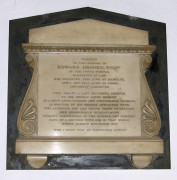
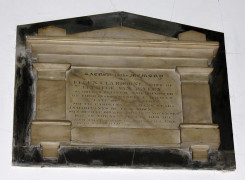
Mid 19th Century chest tomb ends: E. Brooke and Van Zuylen.
- Latham Osborn, d.1846, wife Elizabeth Osborn, d.1849, Lt Thomas Osborn, d.1829,
John Curling Osborn, d.1831, and daughters Frances Osborn, d.1864 and Jane Jessard Osborn, d.1871.
Panel with upper entablature and pediment on similar design to the panel to Ann Turner Brown, with shield of arms
and palm fronds in the pediment.
- Ellen Clarborne van Zuylen, d.1857. Another pedimented panel, but here the style is different,
with a chunky solidity given by the breadth of the side pilasters and their bases, and the weight of the entablature.
The pediment, by contrast, is undersized. A conscious effort to arrive at a new interpretation of the Classical panel.
- Richard Manger Smithett, d.1858, wife Mary Mockett Smithett, d.1870,
and daughter Elizabeth Frances Sankey, d.1859. With an upper shelf, erect crucifix on top, and a backing
cut in a segmented circle.
- John Boys, d.1861, wife Martha Boys, d.1861, and two sons, John, d.1816 and Athelstan, d.1816, children.
Rectangular panel with upper shelf, and painted shield of arms below, on the curved black backing.
- George Yeates Hunter, d.1866, and wife Mary Ann, d.1872 (we saw the monument of William Hunter earlier).
Shaped as a Gothic arch, with narrow border and near the top, a crucifix in a circle. The black backing is also Gothic in shape.
The overall effect is rather modern.
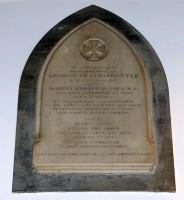
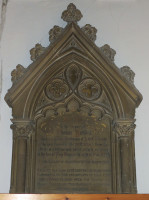
Victorian Gothic panels: Hunter and Boulden monuments.
- Thomas Boulden, d.1867. Another Victorian Gothic panel in stone, with the inscription in the blank window,
quatrefoils etc above, and crocketing on the outer roof. At the sides are attached pillars with leafy capitals;
the base of the monument was obscured by a panel when I visited. Competently carved and typical of the architectural carving
on many buildings of the period.
- Mary Boys, d.1868, husband John Harvey Boys, d.1870, and Athelstan Harvey Boys, d.1873.
Similar to the John Boys panel noted above.
- William Troward Gilder, d.1871, and wife Sarah Maria (Boys), d.1894. Plain panel with upper shelf
on a black backing.
- Susannah Hart, d.1871, and husband John Thomas Hart, d.1874. Another plain panel with upper shelf
on a black backing.
- William Frith Hunter, d.1873. As for the Richard Smithett memorial above, with a crucifix at the top.
- Sophia Jacobs, d.1876. The same again as the William Hunter panel with a crucifix,
except that the sides of the panel slope inwards as we go down, thus as if a casket tomb, but without feet.
20th Century Monuments:
- Percy Wanstall, d.1913, and sons Robert Sloye Wanstall, d.1916, and Elton Cyril Wanstall, d.1915.
Plain panel with bevelled edges and black backing.
- Lt Col. Marbrook Doughty, d.1917, Lt. R. Cecil Doughty, d.1918, their mother
Frances Charlotte Doughty, d.1918, and Frederick James Doughty, d.1946.
An unusual example of a WW1 panel hearkening back to earlier times with ornament rather than the austere plainness
found in the other monuments. The main panel has inscribed upon it pictures of an aeroplane and a machine gun,
and above the upper shelf, is a low panel with military insignia in low relief, and drapery in a wavy arrangement
which looks modern rather than Victorian, but is unusual indeed at this time. I would think that there were originally hanging
drapes on each side of the main inscription, covering the curious shaping we see now. On a black backing.
- Daisy May Cornford, d.1945. Plain panel with bevelled edges.
Brasses
I did not see the ancient brasses in the Church. There are several modern brasses from the late 19th and earlier 20th Centuries:
- Edward Dering, and wife Mary, with small shield at arms and inscribed line border, undated,
but the black letter font suggesting between 1870 and 1910.
- Rt Hon Edward R King-Harman, d.1888. A somewhat more ornate Victorian brass,
with Gothic border with crocketing, pinnacles at the edges, small trefoil tracery, and at the left hand side,
coat of arms in a Gothic trefoil window. A characteristic ornamental piece.
- Anthony Blackburne Cobb, d.1923. Plain, equating to the plain marble panels of the period.
- Percy Harry Richard Venner, d.1934, and Maud Edith Venner, d.1966. Plain horizontal panel
with inscribed line border.
Also in the Church:
- A variety of hatchments, painted, gilded and well cared for - one is pictured at the top of the page.
- An octagonal stone font, shown below, with crumbling low relief decoration of shields and flowers,
and empty niches around the base.
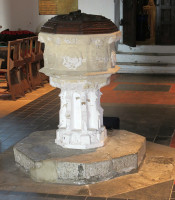
- Considerable woodwork, including roof and pews from the Victorian restoration, and screen from the 1920s
with figures above it of the Crucifixion and two female saints.
- Stained glass, late Victorian.
- A colourful Reredos with Crucifixion and various saints, painted.
- A typical brass Eagle Lectern (see picture at top of page).
Finally, outside in the Churchyard survive a goodly number of headstones, including a group of double-headstones, some
of which are pictured below, and the odd chest tomb and casket, adding considerably to the ambience of the Church.
The pictures of the monuments inside the church are included here with kind permission of the church authorities;
the website of St John the Baptist, Margate is at http://www.stjohnschurchmargate.org.uk/churchfamily-history/.
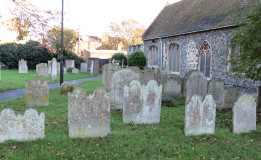
Top of page
Sculpture in Margate // Sculpture in St Peter, near Broadstairs
Sculpture in some towns in England // Sculptors // Introduction to church monuments
Home
Visits to this page from 20 Jan 2015: 8,771








 View of nave, and aisle with monuments.
View of nave, and aisle with monuments.
 Monument to Henry Crispe, d.1588.
Monument to Henry Crispe, d.1588.
 Cartouche to Captain John Petit of Dent de Lyon, d.1700.
Cartouche to Captain John Petit of Dent de Lyon, d.1700.




